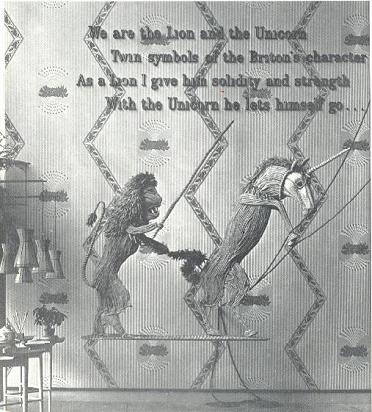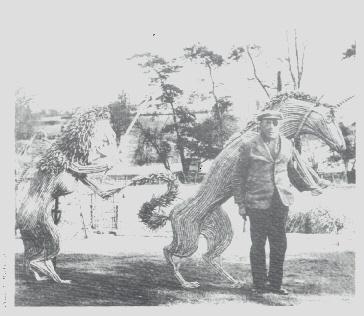


| The Lion and Unicorn in situ in the Pavilion of the same name at the South Bank site for the Festival of Britain 1951. |
|
Fred Mizen was born in an Essex village, Great Samford in 1893. Little is known of his early life but it is known that he worked the various farms around the area of Great Bardfield, where he had moved to and lived out his days. It is said that he had been making corn dollies and other straw works since his childhood, where he had seen them made in the fields by other farm workers. It is known that he served his country in World War One where he lost his left eye and a finger from his left hand. On his return he went gardening for people in the village and surrounding area, no doubt unable to continue with the rigours of farm labouring. He continued making and selling his works during this time. Personal recollections from a number of people attest to this. In the 1940s, a Muriel Rose was to have another corn dolly maker, a Sid Boatman, make a corn dolly to send to New Zealand for an exhibition of English rural crafts. When Fred heard of this, he took the sheaf of wheat and the next day the dolly was done, Muriel getting a lesson in the craft in the process. Although a number of Fredís works are known, only a few remain. Some of these can be seen at the Museum of Rural Life in Berkshire. These include an anchor, some 42inches high, horseshoes, pitch forks, scythes and fire irons. The farm implements are life size. He also made the Barley Queen and the Malting Maid for the Brewery Society to display, these were both 9 feet tall! The pieces that really brought him to the public eye were the Lion and Unicorn for the Pavilion of the same name at the South Bank site for the Festival of Britain 1951. These magnificent beasts stood 7 feet tall. At the time Fred was gardening for John Aldridge, who, with Dick Russell and Hugh Casson (later knighted) were to design parts of the South Bank site. How the Lion and Unicorn came about is a little unclear, maybe the name was given to Fred or he was asked to make two models of his choice for an unnamed pavilion. Perhaps at mealtime he glanced at a bottle of HP sauce with the Royal crest or he remembered the nursery rhyme with the lines; The Lion and the Unicorn were fighting for the crown,
These great creatures took 6 months to build. During their construction, a young Elizabeth Smith, aged 9 at the time, went with her father to deliver flowers to Mrs Mizen and saw them being built. It is said that Fred knew of a mouse building its' nest in one of them but he didn't have the heart to remove it. We know that a mouses nest did appear during the Festival of Britain. After the Festival had closed the Lion and Unicorn went to Selfridges in Oxford Street where the mice in the basement finally destroyed them. The publicity that resulted from the Festival led to something of a revival in interest in Straw plaiting, all from Freds work. As a result of this publicity, a famous firm in Bond Street asked Fred to make some corn dollies for their Christmas stock. He worked hard and delivered his stock by hand. On being told that a cheque would be sent in due course, he took up the dollies and went into the street, selling them all to shoppers going about their Christmas shopping within half an hour. Fred Mizen continued making straw/wheat works until
his death on 19th October 1961. His legacy is the renewed interest
in the craft and since then, many people have taken to teaching and writing
about it. One such venture was by Albert and Vi Ruffle who started
teaching at the Cottage museum in Great Bardfield. This museum can
be visited between Easter and September.
|

|
|
|
|
|
|
| The
Guild of Straw Craftsmen
Brian Mizon Thatching Specialist |
| This page is part of a site using
'frames'
If there are no frames with site contents, click here. |